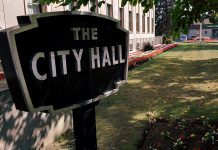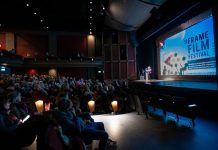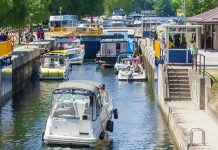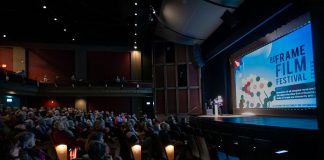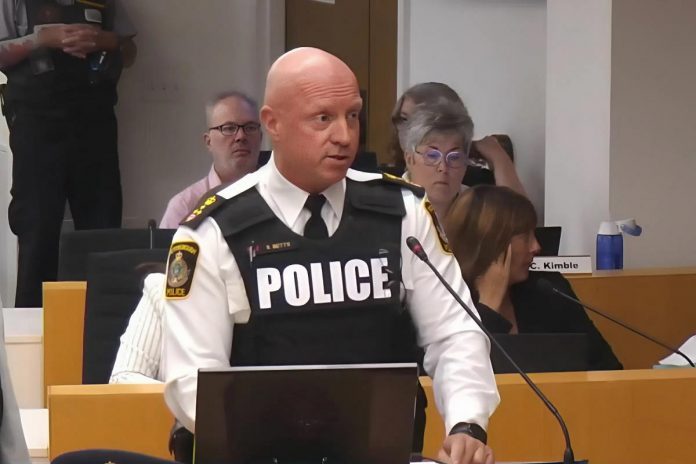
Peterborough city council has voted to defer an update on the project to renovate and expand the city’s police stations that proposes a $25.4 million increase to the project budget, for a total estimated budget of $91.9 million — an increase of over 38 per cent from the original budget of $66.4 million.
Meeting as general committee on Tuesday evening (September 2), council considered a report from the city’s finance and corporate support services commissioner Richard Freymond that described the reasons for the budget increase.
In 2023, city council approved the purchase of a 13.3-acre property at 1421 Lansdowne Street West that was home to the former Johnson & Johnson medical products facility, with a portion of the 106,000-square-foot building to support police services, including additional spaces for training (combative, exercise, classrooms, and firearms), file and equipment storage, meeting and project rooms, IT infrastructure, interview rooms, enlarged lab and property area, additional staff spaces, specialty vehicle storage, and more.
The city purchased the property from Calvary Pentecostal Church for $15.5 million, with the church continuing to use a portion of the building for up to five years.
Council also approved keeping police operations at the existing station at 500 Water Street, maintaining a police presence in downtown Peterborough and resulting in a two-site solution to accommodate policing needs.
In March 2024, council approved appointing Shoalts and Zaback Architects for the design and contract administration of the renovation and expansion project. In February 2025, council approved the city’s 2025 budget, which included $66.4 million for the renovation and expansion of both Lansdowne Street West and Water Street facilities. In April 2025, the city issued an open competition for construction management services and awarded the contract to Matheson Constructors Limited.
Freymond’s report described four changes to the approved budget that would result in the $25.4 million budget increase, summarized below.
- An additional 15,000 square feet of space at a cost of $7.125 million, to accommodate “right-sized” detention cells at Water Street and additional training space at Lansdowne Street West as required by the Ontario building code, policing standards, and requirements of the Community Safety and Policing Act that came into effect in June.
- A new parking garage beside the Water Street police station at a cost of $2.4 million, to address parking deficiencies identified by a traffic consultant for public, staff, and fleet vehicles.
- Energy and building efficiency measures at a cost of $4.375 million to help meet the city’s greenhouse gas reduction targets.
- An additional $11.5 million to cover the $15.5 million purchase cost of the Lansdowne Street West property, as only $4 million was allocated in the original project budget for the purchase. As the city would use just under half of the building and the city would have several acres on the surrounding site, $5,386,600 would be apportioned for future civic administration and $5,060,200 for future development uses.
At Tuesday’s general committee meeting, police chief Stuart Betts and Eric Riddell, partner and architect at Shoalts and Zaback Architects, made a presentation to council on the renovation and expansion project.
Betts described the need for upgrades to meet “critical requirements” including the Community Safety and Policing Act, the Ontario building code, and health and safety, while Riddell presented some renderings of the proposed renovations and expansion at the Water Street and Lansdowne Street facilities.
After the presentation, councillors asked a series of questions about the project and the substantial increase in the budget.
Councillor Alex Bierk asked how much of the additional 15,000 square feet of space is related to legislated versus discretionary needs, whether other options were considered, and why the increased space requirements were not identified when council approved the purchase of the building.
Betts replied that the space increase is “100 per cent required” for detention centres at Water Street, with Riddell noting that the basement at Water Street is not suitable for detention centres. City staff said that the increased space requirements are a result of changes to the Community Safety and Policing Act and the Ontario building code since the original space requirements were identified.
Councillor Matt Crowley asked whether, to reduce the project costs, “best practices” could be addressed in a second phase of the project.
“This isn’t the Cadillac option we’re giving you,” Betts said. “Things have gotten more expensive … the dollars and figures that were allocated at that time, in 2019, were already insufficient to provide the size of police building that was required.”
After Crowley said the “40 per cent cost overrun is very substantial” and “very concerning,” Betts replied “This isn’t an overrun yet because we’re still right-sizing the budget — I would say that you can’t afford not to do this,” adding that the existing Water Street facility is “deficient in every single way.”
“We are 26 years overdue getting up to our adequacy and effectiveness,” Betts said.
Councillor Kevin Duguay asked whether the proposed parking structure could be “consolidated” to include other uses, and whether there was a potential for upper-level residential development.
Using the analogy of a Christmas wish list, councillor Keith Riel asked Betts whether he would prefer a renovated Water Street facility or a new Lansdowne Street West facility — “one or the other.”
“It’s not an either-or,” Betts said. “The option for a one-site solution ended when we did not purchase the $900,000 church at St. Paul’s across from the police station. That was our option; it did not pass at that time. That decision has resulted in this action.”
“Water Street does not have a sufficient footprint to allow to go up or out, other than what we’re talking about here for the detention cells. To try to renovate 1421 (Lansdowne Street West) takes us out of the downtown core — another key element this council has told to me, and the community has told to me, (is) we want our police in the downtown.”
With Riel repeated his question, Betts replied “Your question is irrelevant because it isn’t an either-or” and then, after Riel repeated the question again, “My answer is that it’s an irrelevant question that has no answer.”
After councillor Joy Lachica asked if the Water Street station would be used only for detention rather than police operations, Riddell said that all operations, investigation services, and detention would remain at the downtown location, with the Lansdowne Street West used for training and executive operations. After Lachica asked if Lansdowne Street could also be used for detention, Riddell replied that doing so would increase staff costs at both sites.
Saying that approving the budget increase “feels a little bit like (writing) a blank cheque,” Lachica suggested severing the land at Lansdowne Street West that is not being used and selling it to offset budget costs.
Councillor Lesley Parnell asked about potential revenue opportunities for the parking garage at Water Street and asked Betts whether it would be possible to have housing above the garage. Betts said there was nothing operationally would prevent that, and Riddell said “I would love to see it — I would prefer to see that than just a parking structure.”
Parnell also asked whether the training centre at Lansdowne Street West could be used to offer training to other police departments and possibly the fire department.
Betts replied the training centre will reduce costs as Peterborough police officers would not have to be sent elsewhere for training, but he has also had conversation with other police chiefs about making the training centre a hub for other police services, and also suggested the “biggest bang” would be if a firing range could be included.
Mayor Jeff Leal asked city staff what $66.4 million in 2019 dollars would be in 2025 dollars, and was told it would be $91.9 million because of three to four per cent cost escalation each year.
Councillor Lachica noted that, during the 2025 budget deliberations, the $66.4 million that was approved was not presented as being in 2019 dollars and that doing so now is a “poor argument.”
After questions to Betts and Riddell were completed, councillor Bierk put forward a motion to defer the report back to city staff, asking for details on what costs are related to mandatory versus discretionary requirements. His motion is shown below.
Be it resolved that Report FCSFPM25-028 be referred back to staff, and that Recommendations (b) and (c) not be approved at this time; and that staff report back with:
1. A detailed compliance matrix mapping the specific requirements of the Community Safety and Policing Act, the Ontario Building Code, and any other applicable standards to each facility element and its associated square footage, clearly identifying which elements are mandated and which are discretionary; and
2. A Class C (or better) estimate and life-cycle analysis for two options: (i) 95,000 sq ft (2019 program right-sized for mandates), (II) 110,000 sq ft, each with risk/contingency;
3. A budget showing only police facility costs, excluding Civic Administration or future development, with a defined funding plan and budget cap;
4. Written confirmation that no decision to relocate City Hall or Civic Administration functions to 1421 Lansdowne Street is included in this item, and that any such proposal will require a separate report, costing, public engagement, and Council decision.
“I have written on top of my speech, ‘No, no, no, no, no, enough is enough’ for this,” Bierk said. “This is one of the largest capital asks in our city’s history and it’s being presented in a way that mixes provincially mandated police requirements with optional space, duplication, and multiple possible future city uses without clear and detailed justification.”
“Before we commit taxpayers to this astronomical budget increase, we need clarity. We need to know exactly which project elements are required by law and which are discretionary choices, and we need to make sure the police project stands on its own, with its own budget and cap, not to be tied up with other city ambitions for the site.”
During a debate on Bierk’s motion, councillor Gary Baldwin spoke against deferring the report.
“I have every confidence that our consultants are going to come back and be as judicious as they possibly can, and be as frugal as they possibly can,” Baldwin said, adding that policing is “an expensive business.”
Mayor Jeff Leal referred to a 100,000-square-foot police facility in Sarnia that was originally costed at $81 million and is now $91 million.
“These estimates that we’ve been presented tonight are in the ballpark for what we want to do, and I think it’s time,” Leal said, adding that it’s “our obligation to make sure that that we give (police) the resources necessary to carry out their job each and every day.”
After additional debate, council voted on Bierk’s motion, which carried 6-5, with councillors Lachica, Bierk, Crowley, Riel, Dave Haacke, and Andrew Beamer voting in favour and Mayor Leal and councillors Parnell, Duguay, Baldwin, and Don Vassiliadis voting against.
Items endorsed by general committee will be considered for final approval at the regular council meeting on Wednesday (September 3).





